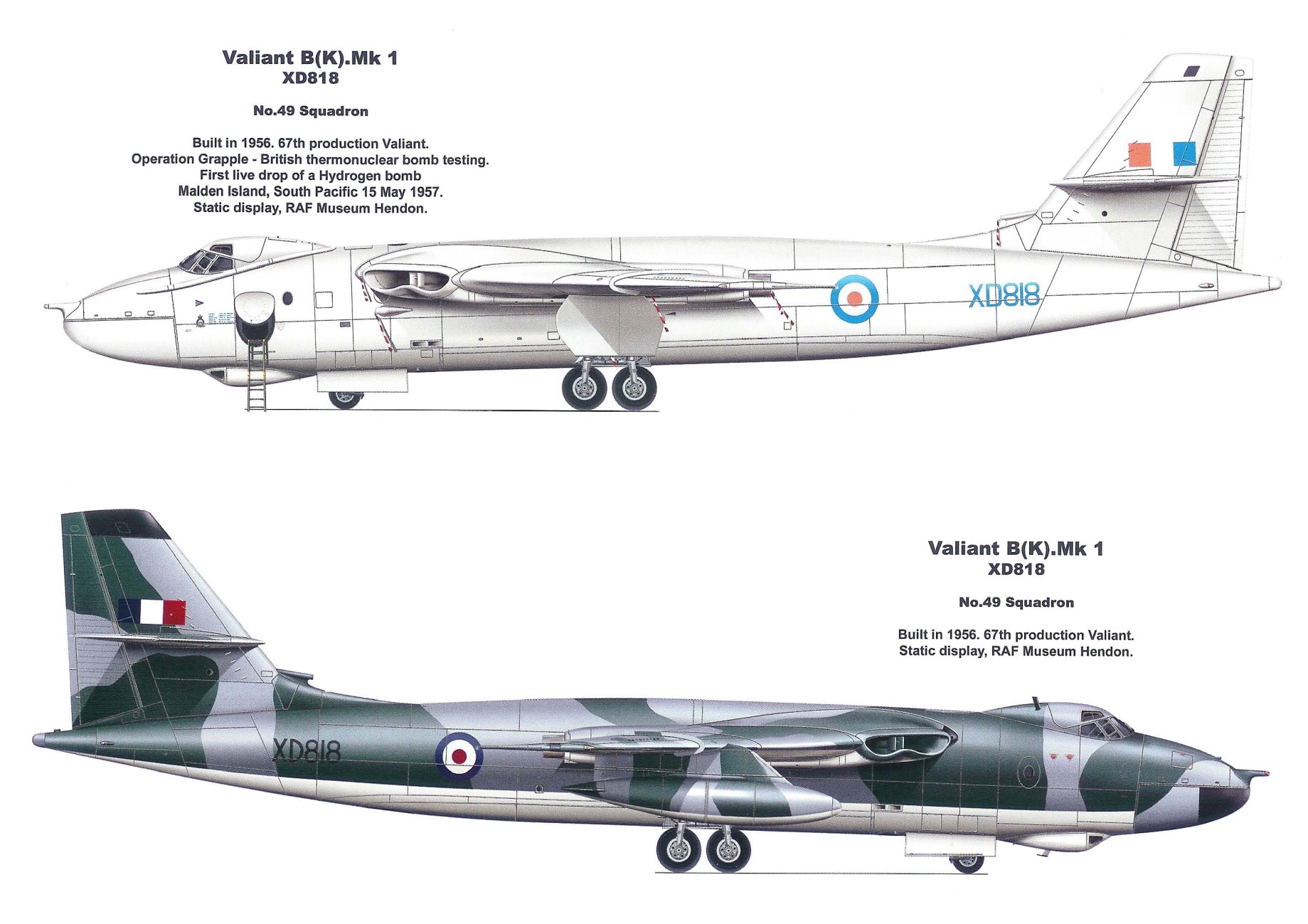
The Valiant was the first of the famous V-bombers and became
the first British aircraft to test-drop nuclear weapons. Ironically, metal
fatigue terminated their short and rather useful service.
The aftermath of the U. S. bombings of Hiroshima and
Nagasaki underscored the necessity of nuclear deterrence to maintain peace and
security in the postwar period. This was especially true in a world dominated
by East-versus-West confrontation. Such prerogatives were in mind when the
British Air Ministry issued Specification B. 35/46 in 1946 for a fleet of
jet-propelled nuclear bombers. Both Avro and Handley Page submitted designs
that were extremely advanced and complicated, culminating in the splendid
Vulcan and Victor bombers. However, rather than go charging off into uncharted
waters, Vickers forwarded a plan that was deliberately less complicated and
promised lower performance. The Air Ministry, wishing it as insurance in case
the more advanced machines failed to materialized, then drew up Specification
B. 9/48 around the craft. The prototype Valiant first flew in 1951 as an
ultramodern, all-metal jet bomber. It was a highwing configuration, with four
jets buried in the wing roots, and a high tail. The Valiant flew well enough to
warrant production, so in 1955 the first 30 examples of the B 1 model became
operational. These were followed by 11 B(PR) 1 reconnaissance versions, 14
B(PR) K 1 reconnaissance/tankers, and 48 BK 1 bomber/tankers. Total production
amounted to 104 machines.
Operationally, Valiants highlighted all the diplomatic and
military perils of the age. In 1956 several flew from Malta and dropped bombs
on Egypt during the Suez Crisis. On October 11 of that same year a Valiant
test-dropped the first British atomic weapon over northern Australia. The feat
was duplicated on May 15, 1957, when a Valiant dropped Britain’s first
thermonuclear device in the Pacific. But as the more capable and modern Vulcans
and Victors became operational, Valiants gradually were transferred to
refueling duties. They were thus employed until 1964, when widespread metal
fatigue caused the active fleet to be scrapped.
Variants
Including three prototypes, a total of 107 Valiants were
built.
Valiant B.1: 39
pure bomber variants, including five pre-production Type 674, which were
powered by Avon RA.14 engines with the same 9,500 lbf (42 kN) thrust each as
the earlier Avon 201 and 34 Type 706 full-production aircraft, powered by Avon
RA.28 204 or 205 engines with 10,500 lbf (47 kN) thrust each, longer tailpipes,
and water-methanol injection for take-off boost power.
Type 710 Valiant
B(PR).1: eight bomber/photo-reconnaissance aircraft. Edwards and his team had
considered use of the Valiant for photo-reconnaissance from the start, and this
particular batch of aircraft could accommodate a removable “crate” in
the bomb-bay, carrying up to eight narrow-view/high resolution cameras and four
survey cameras.
Type 733 Valiant
B(PR)K.1: 13 bomber/photo-reconnaissance/tanker aircraft
Type 758 Valiant
B(K).1: 44 bomber / tanker aircraft. Both tanker variants carried a removable
tanker system in the bomb-bay, featuring fuel tanks and a hose-and-drogue
aerial refuelling system. A further 16 Valiant B(K).1s were ordered, but
cancelled.
Vickers also
considered an air transport version of the Valiant, with a low-mounted wing,
wingspan increased to 140 ft (42.7 m) from 114 ft 4 in (34.8 m), fuselage
lengthened to 146 ft (44.5 m), and uprated engines. Work on a prototype,
designated the Type 1000, began in early 1953. The prototype was to lead to a
military transport version, the Type 1002, and a civilian transport version,
the Type 1004 or VC.7. The Type 1000 prototype was almost complete when it,
too, was cancelled.
Valiant production ended in August 1957.
Specifications (Valiant
B.1)
General
characteristics
Crew: five – two
pilots, two navigators (one navigator plotter + one navigator bomber), air
electronics officer
Length: 108 ft 3
in (32.99 m)
Wingspan: 114 ft 4
in (34.85 m)
Height: 32 ft 2 in
(9.80 m)
Wing area: 2,362
ft² (219 m²)
Empty weight:
75,881 lb (34,491 kg)
Max. takeoff
weight: 140,000 lb (63,600 kg))
Powerplant: 4 ×
Rolls-Royce Avon RA28 Mk 204 turbojet, 10,000 lb (44.6 kN) each
Performance
Maximum speed: 567
mph (493 knots, 913 km/h) at 30,000 ft (9,150 m)
Range: 4,500 mi
(3,910 nmi, 7,245 km) with underwing tanks
Service ceiling:
54,000 ft (16,500 m)
Rate of climb:
4,000 ft/min (20 m/s)
Armament
Bombs:
1 × 10,000 lb
(4500 kg) Blue Danube nuclear bomb or
21 × 1,000 lb
(450 kg) bombs